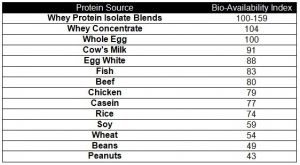Is protein from one source different to protein from another?
Processed vs unprocessed
The biggest difference you will notice between protein sources is the difference between processed and unprocessed sources. You don’t need me to tell you that protein from a chicken breast is better than protein from a cocktail sausage – but why, exactly?
Processed meat contains various chemical compounds which are not naturally present in fresh meat. Many of these compounds are harmful to your health such as poly-cyclic aromatic hydrocarbons from smoking meat. Others are bad when consumed in large quantities, such as sodium, and processed meat tends to easily put you way above your recommended daily intake of these.
It is for these reasons that eating lots of processed meat has consistently been linked to risk of chronic diseases. This doesn’t mean that you can never eat processed meat again, but it is important to prioritise unprocessed sources of protein and avoid eating processed sources daily.
Natural Sources
Looking at the quality of protein from natural sources is very much splitting hairs, but there definitely is a difference in proteins from different sources.
The first and main area of difference is the amino acid profile of the protein. It is important to eat a complete profile of the nine essential amino acids, as each of these have slightly different roles within the process of muscle growth and repair. So, because of this, it is best to prioritise foods or food combinations which allow for a complete amino acid profile. Generally, protein from meats such as poultry, red meat, fish, and dairy will have a complete amino acid profile, whereas plant-based proteins will not and therefore need to be combined with a mixture of protein sources.
The next area that changes between different protein sources is the bio-availability of the protein provided. Bio-availability is a measure of the body’s ability to absorb and use the protein and is based from whole egg protein being 100. Anything higher has a better bio-availability, and anything lower is less bio-available.
Since protein with a higher bio-availability will be more optimally used within bodily functions, it is a good idea to prioritise protein from sources with a high bio-availability. The chart below shows the bio-availability from 14 different sources.
The next difference between protein sources is the micro-nutrients and vitamins which are within the food. For example, red meat is a source of creatine, whereas white meat isn’t. Therefore, if you were to only eat white meat, you would be very low on creatine if you weren’t supplementing directly. Therefore, it is often suggested to get protein from a variety of sources rather than just one – to ensure that you aren’t missing out on the micro-nutrient and vitamins each source will contain uniquely.
The last area of difference between protein sources is the fat ratio, and this is also the easiest to understand. Lean protein sources such as white meats will contain a lower amount of fat to protein per 100g than a red meat for example. This means that white meat will generally be much lower calorie per 100g than red meat, making it a good way of increasing protein intake without going over calorie targets.
This was just one of the questions covered in our latest “Let’s Talk: Nutrition” evening. Our next talk will be held with Ash at tfd on Friday 28th February at 7pm. This is free to members and they can book now via the FitSense app.


